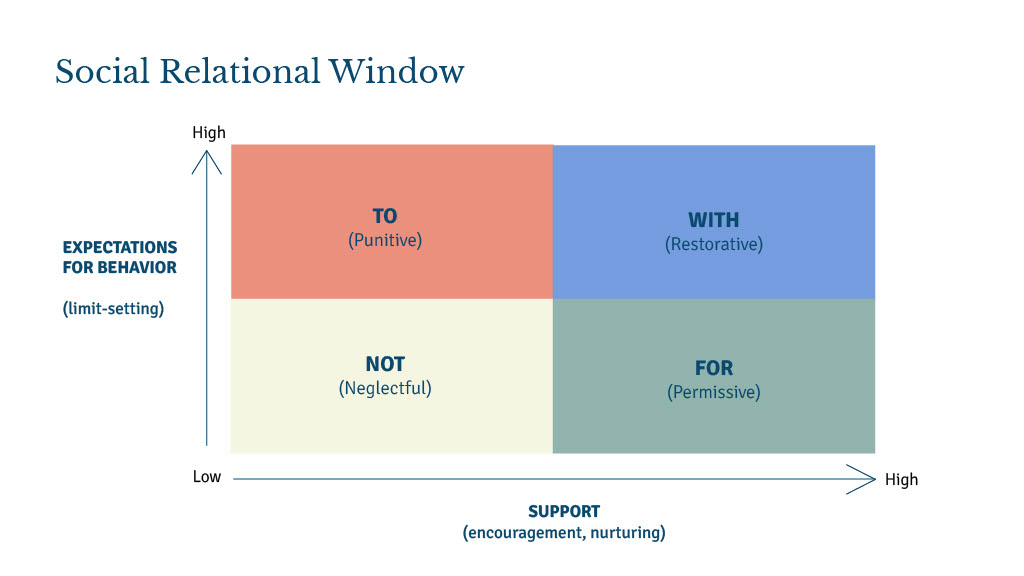
Restorative justice is a paradigm shift. In making this shift, conceptual models help us understand and explain a restorative approach and how it differs from other approaches.
One of our favorite models to use is the Social Relational Window.
The Social Relational Window is an intentional combination of Paul McCold and Ted Wachtel’s “Social Discipline Window” and Dorothy Vaandering’s “Relationship Widow.” In this blog post, we will explain those two original models before giving an overview of the Social Relational Window and some relevant examples. The Social Discipline Window model was first brought into the restorative justice field by Paul McCold and Ted Wachtel (2003).[1] The Social Discipline Window describes four basic approaches to addressing challenging or disruptive behavior. Restorative practitioners use this tool to gauge an effective response to a specific incident or ongoing issue. The four strategies are represented as different combinations of high or low control and high or low support. While we have found this model very helpful, we have always been troubled by the word “control” and the tone that word sets when thinking through application of the model.

In 2010 (published in 2013), Dorothy Vaandering introduced an alternative version of the model called the “Relationship Window.” The Relationship Window sought to shift the focus of the model from emphasizing behavior to emphasizing relationships. In offering this new model, Vaandering endeavored to address what her research found as a common problematic outcome of the use of the Social Discipline Window by teachers: a primary focus on managing or controlling behavior from a place of authority over students that ultimately was counter to the restorative ethos.[2] This model refocuses on the relational needs of the community and individual more broadly.

We have found both models very helpful in our own growth and development as restorative practitioners and educators, and also in relationships with our friends, family, and coworkers. When we teach the model, we use a version that combines aspects of both the Vaandering model and the McCold/Wachtel model. We call this adaptation the Social Relational Window.
The Social Relational Window describes four basic approaches to maintaining social norms and behavioral boundaries. The four approaches are represented as different combinations of high or low expectations of behaviors and high or low support. High expectations of behavior paired with low support is a punitive or “to” approach. High support paired with low expectations of behavior is a permissive or “for” approach. Low support paired with low expectations of behavior is a neglectful or “not” approach. The restorative domain combines high expectations of behavior with high support and is characterized by doing things “with” people, rather than “to” them or “for” them.

Take, for example, a student who is repeatedly disruptive in class, speaking over the teacher and making loud comments and jokes.
The Neglectful strategy is to not do anything, to hope that the student will just eventually stop.
The Punitive strategy is punishment, doing something to the person who is misbehaving. The teacher might give the student detention or remove privileges like being able to come on a field trip. The strategy holds the student to a high expectation of behavior, but has very little support or curiosity about the need at the root of the student’s behavior. This strategy may result in animosity between the teacher and student, and will not address the core issues or needs contributing to the problematic behavior.
The Permissive strategy is when we do things for someone. We accept their excuses or make excuses for them. The teacher might tell herself that the student is just trying to be liked by the other students because he has been having trouble making friends, or that his unrestrained enthusiasm is a sign that he is enjoying the class. A possible outcome is that other students, seeing that a high expectation of behavior is not upheld, will similarly begin to speak out of turn, and the teacher will slowly lose the respect of the class and the ability to facilitate an effective learning space.
The Restorative strategy is when we work with the person to resolve the issue. The teacher would speak with the disruptive student one-on-one, explain the impacts of his disruptive behavior, and respectfully ask the student about his experience and what is going on. This opens a dialogue and allows the teacher to find out what needs are contributing to the student’s misbehavior. Is the student having trouble with friends? Are there troubles at home that are impacting the student’s behavior at school? Are there other more productive ways that the student could channel their energy to be an outgoing leader in the classroom? Does the student need varied material or engagement to challenge him and keep him on task? The teacher and student would work together to understand the barriers to meeting the behavior expectations and how those barriers can be addressed.
To deepen your restorative justice practice, take time for self-reflection to identify which strategy in the Social Relational Window is your default response. Are you prone to avoiding conflict and doing nothing, jumping straight to punishment, or making or accepting excuses for poor behavior? How do your responses change depending on the circumstance? Knowing this about yourself will help you to know which direction you need to push yourself. Do you need to remind yourself to hold high expectations of behavior with the people in your life or do you need to remember to take a step back and show support?
In each of the communities and interactions that make up our lives, the Social Relational Window offers us a tool for thinking about how to approach issues and conflicts more restoratively.